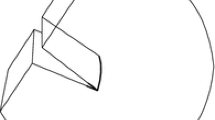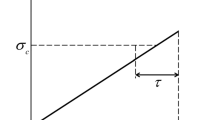Abstract
A simple and flexible method of analysis on stable crack growth in ductile materials is presented. The analysis is based on an elastic-plastic finite element method to calculate the stress and displacement fields in the vicinity of a growing crack under monotonically increasing load. A special type of element known as a “breakable element” and a nodal force relaxation technique have been adopted in a usual elastic-plastic analysis to simulate stable crack growth. A new fracture criterion which is suitable for mixed mode fracture is also used. The computational scheme was verified by excellent correlation with some experimental results.
Résumé
On présente une méthode simple et flexible pour l'analyse de la croissance stable d'une fissure dans les matériaux ductiles. L'analyse est basée sur une méthode par éléments finis élasto-plastiques permettant de calculer les champs de contrainte et de déplacement au voisinage d'une fissure en croissance sous charges monotonique croissante. On a adopté un type spécial d'éléments, dénommé éléments fragmentables, et une technique de relaxation des forces nodales dans une analyse élasto-plastique habituelle, pour simuler la croissance stable d'une fissure. Le nouveau critère de rupture applicable à une rupture de mode mixte a également été utilisée; certains résultats expérimentaux ont permis de vérifier l'excellente corrélation du schéma de calcul proposé.
Similar content being viewed by others
References
D. Brock,International Journal of Fracture 4 (1968) 19–34.
G.R. Irwin, J.A. Kies and H.L. Smith,Proceeding of American Society for Testing and Materials 58 (1958) 640–660.
A.A. Wells, “Application of Fracture Mechanics at and beyond General Yield”, British Welding Research Association Report M13/63 (1963).
J.R. Rice, inFracture: An Advanced Treatise, edited by H. Liebowitz, Academic Press, Vol. 2 (1968) 191–311.
Fracture Toughness Evaluation by R-Curve Methods, ASTM STP 527 (1973).
H. Liebowitz and J. Eftis,Engineering Fracture Mechanics 3 (1971) 267–281.
F.A. McClintock and G.R. Irwin, inFracture Toughness Testing and Its Applications, ASTM STP 381 (1965) 84–113.
J.R. Rice, inMechanics and Mechanisms of Crack Growth, (Proceedings of Conference at Cambridge, England, April 1973), edited by M.J. May, British Steel Corporation Physical Metallurgy Centre Publication (1975) 14–39.
H. Anderson,Journal of the Mechanics and Physics of Solids 21 (1973) 337–356.
A.U. de Koning inFracture 1977 (Proceedings of the Fourth International Conference on Fracture, University of Waterloo, June 1977), University of Waterloo Press, Vol. 3, 25–31.
S.R. Varansi, inFlaw Growth and Fracture, ASTM STP 631 (1977) 507–519.
A.U. de Koning, D.P. Rooke and C. Wheeler, inProceedings of International Conference on Numerical Methods in Fracture Mechanics, Swansea (January 1978) edited by A.R. Luxmoore and D.R.J. Owen, 525–536.
M.F. Light and A.R. Luxmoore,Journal of Strain Analysis 12 (1977) 293–304.
R.G. Belie and J.N. Reddy,Computers & Structures 11 (1980) 49–53.
J.D. Lee and H. Liebowitz,Computers & Structures 8 (1978) 403–410.
A.F. Kfouri and K.J. Miller, inProceedings of Institute of Mechanical Engineers 190 (1976) 48–76.
J.R. Rice and E.P. Sorensen,Journal of Mechanics and Physics of Solids 26 (1978) 163–186.
C.F. Shih, H.G. deLorenzi and W.R. Andrews, inElastic-Plastic Fracture, ASTM STP 668 (1979) 65–120.
M.F. Kanninen, E.E. Rybicki, R. B. Stonesifer, D. Brock, A.R. Rosenfield, C.W. Marshall and G.T. Hahn,Ibid., 121–150.
E.P. Sorensen,Ibid., 151–174.
K.J. Miller and A.P. Kfouri,Ibid., 214–228.
Y. D'Escatha and J.C. Devaux,Ibid., 229–248.
J.C. Newman, Jr., inCyclic Stress-Strain and Plastic Deformation Aspects of Fatigue Crack Growth, ASTM STP 637 (1977) 56–80.
K. Ohji, K. Ogura and Y. Ohkubo,Engineering Fracture Mechanics 7 (1975) 457–464.
D.F. Socie,Engineering Fracture Mechanics 9 (1977) 849–865.
T.R. Hsu and A.W.M. Bertels,Journal of Pressure Vessel Technology, ASME Transaction 98 (1976) 17–25.
T.R. Hsu and Y.J. Kim, “On Slow Crack Growth in Fuel Cladding by Finite Element Analysis”, C3/12, 5th International Conference on Structural Mechanics in Reactor Technology (1979).
T.R. Hsu, A.W.M. Bertels, S. Banerjee and W.C. Harrison, “Theoretical Basis for a Transient Thermal Elastic-Plastic Stress Analysis of Nuclear Reactor Fuel Elements”, AECL-5233, Atomic Energy of Canada Ltd., Pinawa, Manitoba, Canada (1976).
T.R. Hsu and A.W. Bertels,AIAA Journal 12 (1974) 1450–1452.
S.Y. Cheng and T.R. Hsu,International Journal for Numerical Methods in Engineering 12 (1978) 1617–1627.
Author information
Authors and Affiliations
Rights and permissions
About this article
Cite this article
Kim, Y.J., Hsu, T.R. A numerical analysis on stable crack growth under increasing load. Int J Fract 20, 17–32 (1982). https://doi.org/10.1007/BF00942162
Received:
Revised:
Issue Date:
DOI: https://doi.org/10.1007/BF00942162




